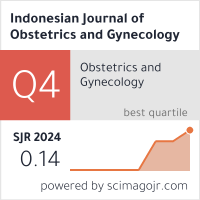Letrozole 2.5 mg Shows Higher Endometrial Thickness Compared to 5 mg Letrozole in Ovulation Induction
Abstract
Objective: To compare the effects of ovulation induction with 2.5 mg letrozole to 5 mg letrozole by the number of mature follicles, endometrial morphology and endometrium thickness during the late follicular phase in infertility patient who successfully became pregnant. Method: This was a cross sectional study. We collected the data of infertility patient who successfully became pregnant after receiving ovulation induction regiment of 2.5 mg and 5 mg letrozole. Result: There mean number of follicles with diameter ≥ 18 mm was higher in group receiving 5 mg letrozole (1.64 SD ± 0.91) compared to group receiving 2.5 mg letrozole (1.37 SD ± 0.56) but statistically, there was no significant difference (p = 0.134). Endometrial thickness, which was measured by transvaginal ultrasound on the twelfth day of menstrual cycle, showed a significant difference (p = 0.023) between the groups. The endometrium was thicker in patients receiving 2.5 mg letrozole (7.83 mm SD ± 0.87) compared to patients receiving 5 mg letrozole (7.6 mm SD ± 1.10). The most common endometrium morphology found was triple line endometrium, both in group receiving 2.5 mg letrozole (65%) and in group receiving 5 mg letrozole (50%). Conclusion: There was a significant difference in endometrial thickness between the pregnant patients who had received 5 mg of letrozole and 2.5 mg of letrozole for ovulation induction and the most common endometrium morphology and description was triple line endometrium in both research groups. But there was no significant difference between the number of ≥ 18 mm follicles on 2.5 mg doses and 5 mg doses of letrozole. [Indones J Obstet Gynecol 2012; 36-3: 130-4] Keywords: endometrium morphology, endometrium thickness, infertility, letrozole, ovarium follicles
Downloads
Copyright (c) 2020 Indonesian Journal of Obstetrics and Gynecology

This work is licensed under a Creative Commons Attribution-NonCommercial-ShareAlike 4.0 International License.













